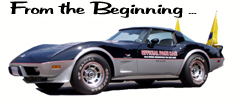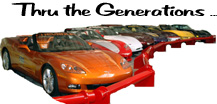|
1986
marked the return of the convertible Corvette, with
the last model produced in 1975.
A
contributing factor to the cancellation of the convertible
after 1975 was that so few were produced (4,269 of 38,465).
This is due in part to some public concern about convertible
safety in the '70s.
In
1984, the new C4 body style provided enough strength
to go to a Targa Top design, which allowed the elimination
of the center bar. Many
Corvette buyers, as well as many in Chevrolet, wanted
the return of a convertible. But re-design costs and
assembly plant complications caused a convertible program
to be kept on the back burner.
So
how did the convertible get back on the table? Lloyd
Reuss (pronounced "Royce"), who had been Chevrolet's
Chief Engineer and later, General Manager of Buick,
was a performance-car guy and was very fond of the Corvette.
He also favored a convertible option.
At
the time, a Detroit company called American Sunroof
Corporation (ASC) was doing after-market convertible
conversions for a number of manufacturers and private
owners. Its CEO, Heinz Prechter, built the business
from a small sunroof installation company to a major
conversion firm. Reuss and Prechter were business associates
and personal friends. Hoping to sell GM on ASC's convertible
conversion business, Prechter created a 1984 convertible
prototype.
Back
at Chevrolet, Reuss asked the Corvette group to investigate
the possibility of reintroducing a Corvette convertible.
The group determined it was feasible and would be more
cost-effective if it were a Chevrolet-designed and -built
vehicle rather than an after-market conversion. With
that, build plans were put in place for a reintroduction
of the convertible for the 1986 model year.
In
recognition of being named the 1986 Indianapolis 500
Pace Car, all of the new Corvette convertibles were
identified as Pace Car Replicas, and so badged. Although
the Indy Pace Car was painted yellow, convertibles could
be ordered in other colors as well. And for 1986, 7,315
of the newly reintroduced convertibles were ordered,
nearly 21 % of total Corvette production. All convertibles
included the Official Indianapolis 500 graphics in their
cars and could be installed by the owners if they liked.
Corvette
convertibles of various colors were sent to the Speedway
that year to perform duties of Official Event vehicles.
The
convertible and coupe carried different VIN number ranges,
so the last six digits of the VIN also identify the
build sequence of the car in the convertible range (900001-907315).
Click
HERE
to view the complete list of Corvettes assigned to the
track this year for race support.
Corvette
exterior colors were:
-
Silver Metallic
-
Medium Gray Metallic
-
Medium Blue Metallic
- Yellow
-
White
-
Black
-
Gold Metallic
-
Silver Beige Metallic
-
Copper Metallic (only 4 total cars built)
-
Medium Brown Metallic
-
Dark Red Metallic
-
Bright Red.
Two-tone
combinations were :
-
Silver and Gray
- Gray
and Black
-
White and Silver
-
Silver Beige and Medium Brown
-
Silver Beige and Black.
Several
of the graphic pieces that came with the cars also varied
in color, primarily to accent the body color of the
car. Color choices were :
- Gold
(with black "70th Indianapolis 500")
- Gold
(with gold "70th Indianapolis 500")
- Gold/Gold
(for black cars only)
- Silver
Interior
trims came in Blue;
Black; Bronze; Graphite; Medium Gray; Red; Saddle; and
White.
The
soft-top was back!
|



